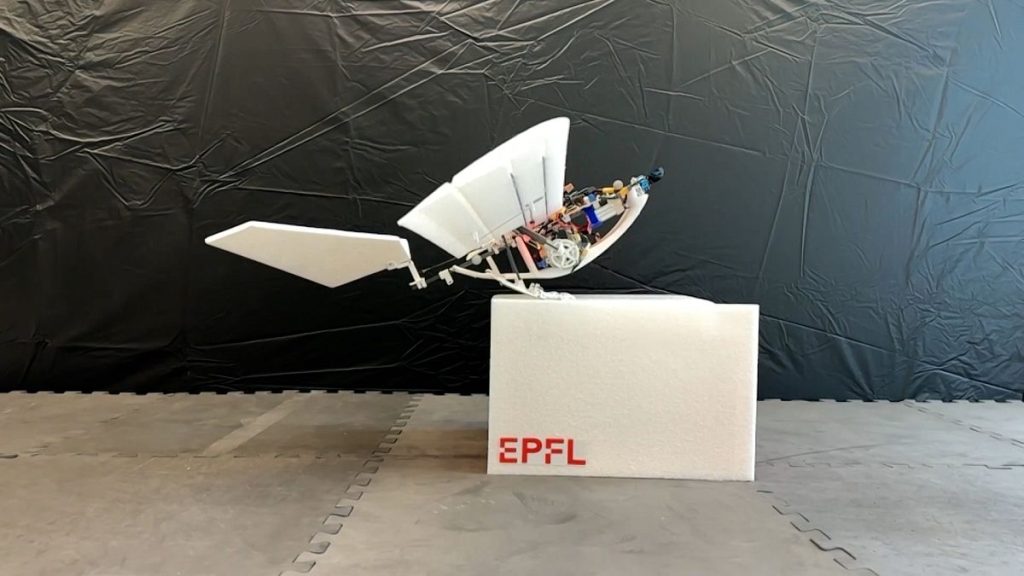RAVEN: A Bird-Inspired Robot for Complex Terrain Navigation
Researchers at the Swiss Federal Institute of Technology in Lausanne (EPFL) have developed a groundbreaking robot called RAVEN, designed to seamlessly transition between ground and air locomotion, mimicking the remarkable abilities of birds. This innovative robot integrates walking, jumping, and hopping capabilities with fixed-wing flight, opening up exciting possibilities for applications in challenging environments, particularly in rescue missions and remote deliveries.
RAVEN’s design draws inspiration from the agility and versatility of birds, especially their ability to navigate complex terrains and effortlessly transition between walking, hopping, and flying. Birds achieve this seamless transition by utilizing their legs and wings in a coordinated manner, providing both stability and propulsion. The research team aimed to replicate this functionality in a robotic system, recognizing the potential for improved maneuverability and access to previously inaccessible areas.
The robot’s locomotion system features a "hip" and "ankle" joint, allowing for walking and hopping movements. While birds possess more actuated joints, providing greater dexterity, RAVEN’s simplified design proves effective for its intended purpose. When combined with its V-shaped tail and fixed wings, the robot resembles a bird in both form and function. A key feature of RAVEN’s design is its jump-based takeoff mechanism, inspired by the efficient flight initiation observed in birds. This approach proved more effective than traditional propeller-based takeoff methods, particularly in cluttered environments.
The motivation behind RAVEN’s development stems from the need for effective robotic solutions in disaster situations, specifically in areas with complex terrain that hinders traditional wheeled or tracked robots. Birds, with their ability to navigate cluttered spaces with ease, served as the perfect inspiration for a robot designed to operate in such environments. The researchers envision RAVEN as a valuable tool for accessing remote or disaster-stricken locations, providing assistance in search and rescue missions and delivering essential supplies.
The research team anticipates that a scaled-up version of RAVEN could revolutionize rescue missions and parcel deliveries in remote or difficult-to-reach areas. The robot’s multi-modal locomotion capabilities allow it to cover large distances using fixed-wing flight, land precisely in the target area, and then navigate the remaining distance on the ground through walking or hopping. This combined approach overcomes the limitations of purely aerial or ground-based robots, offering greater flexibility and adaptability to varying terrains. Upon completing its mission, RAVEN can simply jump and take off, returning to its base or proceeding to another location.
Future development plans for RAVEN include incorporating foldable wings, further enhancing its maneuverability in confined spaces. This feature will enable the robot to navigate narrow passages and access areas that are currently inaccessible to fixed-wing drones. Additionally, the integration of advanced sensors will equip RAVEN with autonomous landing capabilities, increasing its autonomy and operational efficiency. These improvements will further solidify RAVEN’s position as a versatile and robust robotic solution for challenging environments. The research team’s innovative approach, inspired by the natural world, has resulted in a robot with the potential to significantly impact disaster response and remote area access. The development of RAVEN showcases the power of bio-inspired design in creating effective solutions to real-world problems. The unique combination of aerial and terrestrial locomotion, coupled with future enhancements, promises to unlock new possibilities for robotics in diverse and complex environments. The study on RAVEN was published in the scientific journal Nature in December, further highlighting the significance and potential of this groundbreaking research.














